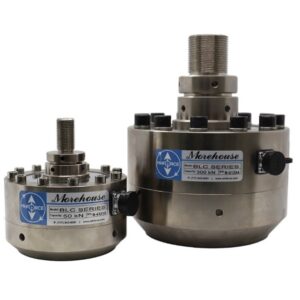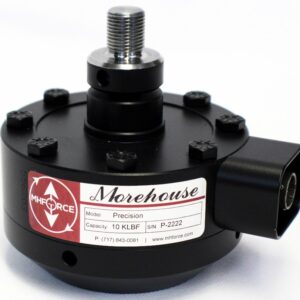Voltage Excitation Applied to a Load Cell: Introduction

Most load cells are force sensors that receive a voltage (excitation) from a regulated power source (usually a digital indicator or signal conditioner) and send back a low voltage signal (signal) when force is applied.
Most load cells are designed to operate at 10V, and many will operate fine at 5V.
For bonded foil gauges, there are two competing factors for determining bridge excitation voltage.
1) Higher voltages improve the signal-to-noise ratio of the low output from Wheatstone bridges
2) Higher voltages increase the self-heating of the strain gauge.
Modern instrumentation can give good results at a much lower voltage than when excitation voltages were standardized decades ago.
From the electronics standpoint, 10V, 5V, or even 2.5V will not produce a noticeable difference in most applications if they are used at the same voltage they are calibrated at.
The self-heating effect, on the other hand, can be significant.
Raising or lowering the excitation voltage from what it was calibrated can affect span, temperature compensation, creep, and stability.
Using the same calibrated excitation voltage is mandatory for high-end reference load cells.
ASTM E74 and ISO 376 Requirements regarding Voltage Excitation Applied to a Load Cell
ASTM E74 and ISO 376 have a mandatory requirement that any meter substitution must have the same excitation voltage, amplitude, frequency, and waveform.
ASTM E74 in section 12.1.3 states, "Excitation voltage amplitude, frequency, and waveform shall be maintained in the substitution within limits to ensure that the effect on the calibration is negligible. A user is responsible for determining limits on these parameters through measurement uncertainty analysis and appropriate tests to ensure that this requirement is met. Substitution of an interconnect cable can have a significant effect on calibration." (1)
ISO 376 in section 5 states, "The units and excitation source of the replacement indicator should be respectively of the same quantity (e.g., 5 V, 10 V) and type (e.g., AC or DC carrier frequency)." (2)
Testing Voltage Excitation Applied to a Load Cell Using a Morehouse 4215

Figure 2 Calibration results comparing a 5V and 10V DC Excitation Applied to a Load Cell
At Morehouse, we have tested various load cells and meters using 5- and 10-volt DC excitation, different carrier frequencies such as AC versus DC, and different filter settings.
When we conducted this test, we used our 12,000 lbf deadweight machine known to be within 0.0016 %; we did not move the load cell; we applied a series of forces using the 5V DC indicator setting, switched to the 10V DC setting and repeated the same series of forces.

The goal was to isolate the difference between 5 and 10V excitation on a Morehouse Shear-web load cell.
The above results in Figure 2 show a consistent difference on most applied forces of 0.01 %.
We feel our test method was sound, and the difference was noticeable.
If the use case was for a reference standard, a change of 0.01 % is likely too high, as the results were consistent in the output change.
The lower voltage on this load cell increased the overall output. We discussed other factors like carrier frequency and filtering settings.
Our article on AC versus DC can be found @ AC Versus DC (mV/V) Important Differences in Load Cell Meters Using a Load Cell Simulator | Morehouse Instrument Company, Inc. (mhforce.com)
The article comparing different filter settings can be found @Comparing Load Cell Meter Filter Settings on Morehouse 4215 Load Cell Meters | Morehouse Instrument Company, Inc. (mhforce.com)
The takeaway from all these tests is to send your equipment with your settings to the calibration provider to replicate use and eliminate additional errors.
Voltage Excitation Applied to a Load Cell: General Information about 5 and 10V Excitation on a Load Cell
5V DC Excitation: Load cells with 5V DC excitation are designed to operate with a 5-volt direct current power supply.
10V DC Excitation: Load cells with 10V DC excitation require a 10-volt direct current power supply.
This higher voltage can sometimes provide a better signal-to-noise ratio, potentially improving the overall performance of the load cell.
Voltage Excitation Applied to a Load Cell Signal Strength:
5V DC Excitation: A 5V excitation voltage is generally sufficient for many applications, but it may result in a lower signal strength than a 10V excitation.
This could potentially impact the precision of measurements in certain situations.
10V DC Excitation: A higher excitation voltage, such as 10V, can provide a stronger signal.
This can be advantageous in applications where a higher level of sensitivity and precision is required.
Voltage Excitation Applied to a Load Cell Noise Sensitivity:
5V DC Excitation: Lower excitation voltages may be more susceptible to electrical noise.
Care should be taken to minimize interference in the signal path to ensure accurate measurements.
10V DC Excitation: The higher excitation voltage may contribute to a better signal-to-noise ratio, potentially reducing sensitivity to electrical interference.
Voltage Excitation Applied to a Load Cell Compatibility:
5V DC Excitation: Load cells with 5V excitation are more common and may be preferred in applications where the sensor is specifically designed for 5V operation., generally smaller load cells like button or pancake cells.
10V DC Excitation: Some load cells are designed to work optimally with 10V excitation.
It's essential to check the specifications of the load cell and ensure compatibility with the chosen excitation voltage.
Voltage Excitation Applied to a Load Cell General Rules of Thumbs:
-Smaller load cells are more sensitive to excitation voltage.
Most loadcells under 1.5" diameter will be more stable at 5V than 10V.
-Lower capacity loadcell is more sensitive to the excitation voltage
-Higher bridge resistances are less sensitive to excitation voltage.
This can allow smaller transducers to use larger excitation voltages.
-Applications that affect heat transfer, like high ambient temperature or vacuum environment, may require lower excitation
-Higher voltage requires a longer warmup time
Voltage Excitation Applied to a Load Cell: Conclusion
We have learned that voltage excitation applied to a load cell produces a difference in output between excitation and waveform.
ASTM E74 and ISO 376 address this by saying any meter substitution must match the same excitation, frequency, and waveform listed above.
Even filtering (filter) settings can make a difference in output.
Our tests using the same Morehouse 4215 meter and calibration machine, using a Morehouse shear web load cell, showed a difference of about 0.01 % between 5 and 10 volts.
However, it's more of a trap to think any error for most load cells would be within 0.01 %, as these differences depend on the design of the load cell.
Some smaller cells will operate better at 5-volt DC excitation, meaning the difference between 5 and 10-volt DC excitation will be much more significant.
Thus, our conclusion on it is to standardize your process and meters.
Choose the best filtering settings for your application and send all the instructions to the calibration lab performing the calibration, hopefully, Morehouse.
Voltage Excitation Applied to a Load Cell References
- ASTM E74 Standard Practices for Calibration and Verification for Force-Measuring Instruments Section 8
- ISO 376 Metallic materials — Calibration of force-proving instruments used for the verification of uniaxial testing machines Section 7
For more insights into force and torque calibration, metrology, and load cell reliability, explore our comprehensive blog at https://mhforce.com/blog/.
About Morehouse Instrument Company
Companies worldwide rely on Morehouse for accuracy and speed. The company turns around equipment in 7-10 business days so customers can return to work quickly and save money.
The York, PA-based company provides force and torque measurement products and services worldwide.
Morehouse Instrument Company, a trusted and accredited provider of force and torque measurement services for over 100 years, offers measurement uncertainties 10-50 times lower than the competition.
Morehouse helps commercial labs, government labs, and other organizations lower their measurement risk by lowering equipment uncertainties for torque and force measurement. Contact Morehouse at info@mhforce.com .
More Information about Morehouse
We believe in changing how people think about force and torque calibration in everything we do.
This includes setting expectations on load cell reliability and challenging the "just calibrate it" mentality by educating our customers on what matters and what causes significant errors.
We focus on reducing these errors and making our products simple and user-friendly.
This means your instruments will pass calibration more often and produce more precise measurements, giving you the confidence to focus on your business.
Companies around the globe rely on Morehouse for accuracy and speed.
Our measurement uncertainties are 10-50 times lower than the competition.
We turn around your equipment in 7-10 business days so you can return to work quickly, saving you money.
When you choose Morehouse, you're not just paying for a calibration service or a load cell.
You're investing in peace of mind, knowing your equipment is calibrated accurately and on time.
Contact Morehouse at info@mhforce.com to learn more about our calibration services and load cell products.
Email us if you ever want to chat or have questions about a blog.
We love talking about this stuff.
Our YouTube channel has videos on various force and torque calibration topics here.
# Voltage Excitation Applied to a Load Cell


